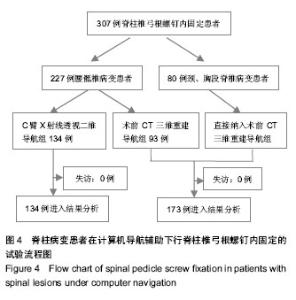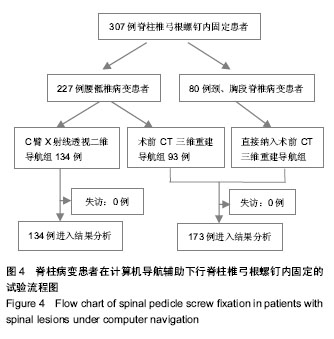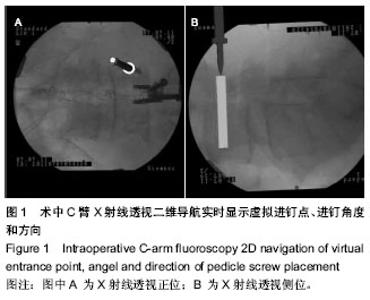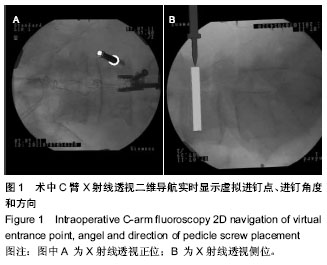Chinese Journal of Tissue Engineering Research ›› 2015, Vol. 19 ›› Issue (13): 2119-2124.doi: 10.3969/j.issn.2095-4344.2015.13.028
Previous Articles Next Articles
Computer navigation technique-assisted posterior spinal pedicle screw placement fixation: accuracy and safety
Chen Xiao-ming, Xiao Zeng-ming, Zong Shao-hui, Chen Qian-fen
- Department of Spine & Osteopathy, the First Affiliated Hospital of Guangxi Medical University, Nanning 530021, Guangxi Zhuang Autonomous Region, China
-
Received:2015-02-16Online:2015-03-26Published:2015-03-26 -
Contact:Chen Qian-fen, M.D., Chief physician, Department of Spine & Osteopathy, the First Affiliated Hospital of Guangxi Medical University, Nanning 530021, Guangxi Zhuang Autonomous Region, China -
About author:Chen Xiao-ming, Attending physician, Department of Spine & Osteopathy, the First Affiliated Hospital of Guangxi Medical University, Nanning 530021, Guangxi Zhuang Autonomous Region, China -
Supported by:the Science and Technology Development Plan Project of Guangxi Zhuang Autonomous Region, No. 1298003-5-1, 2012-ky00-10
CLC Number:
Cite this article
Chen Xiao-ming, Xiao Zeng-ming, Zong Shao-hui, Chen Qian-fen. Computer navigation technique-assisted posterior spinal pedicle screw placement fixation: accuracy and safety[J]. Chinese Journal of Tissue Engineering Research, 2015, 19(13): 2119-2124.
share this article
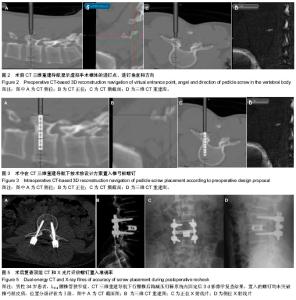
2.1 参与者数量分析 所有患者均在术后第3天复查X射线及双能CT,以评估所置入椎弓根钉的准确率,无一例失访。患者试验流程图见图4。 2.2 影像学结果 术后第3天行双能CT扫描置钉节段及X射线检查,根据Andrew椎弓根螺钉CT 位置分级标准对置入椎弓根螺钉位置进行评价。以一位34岁L3-4腰椎管狭窄症男性患者为例,术前CT三维重建导航下行腰椎后路减压钉棒系统内固定后3 d影像学复查结果,置入的螺钉均未突破椎弓根皮质,位置分级评估为Ⅰ级(图5)。 2.3 螺钉置入准确率 2.3.1 螺钉置入总准确率 总共置入螺钉1 820枚,其中1 778枚为Ⅰ级螺钉(准确率97.69%),42枚为Ⅱ级螺钉(2.31%),无Ⅲ级螺钉。 2.3.2 颈椎螺钉置入准确率 共置入螺钉92枚,Ⅰ级螺钉90枚(准确率97.82%);Ⅱ级螺钉2枚(2.17%),无Ⅲ级螺钉。 2.3.3 胸椎螺钉置入准确率 共置入螺钉502 枚,Ⅰ级螺钉492枚(准确率98.01%);Ⅱ级螺钉10枚(1.99%),无Ⅲ级螺钉。 2.3.4 腰骶椎螺钉置入准确率 共置入螺钉1 226 枚,Ⅰ级螺钉1 196枚(准确率98.01%);Ⅱ级螺钉30枚(2.44%),无Ⅲ级螺钉。其中,在术中C臂X射线透视二维导航引导下共置入螺钉724 枚,Ⅰ级螺钉702枚(准确率96.96%),Ⅱ级螺钉22枚(3.04%);在术前CT三维重建导航下共置入螺钉502枚,Ⅰ级螺钉494枚(准确率98.41%),Ⅱ级螺钉8枚(1.59%)。两种导航模式下,腰骶椎螺钉置入准确率差异无显著性意义(P > 0.05)。 2.4 置钉时间 307例患者的每枚螺钉平均置钉时间为(7.0±1.5) min。227例腰骶椎病变患者中,134例采用术"
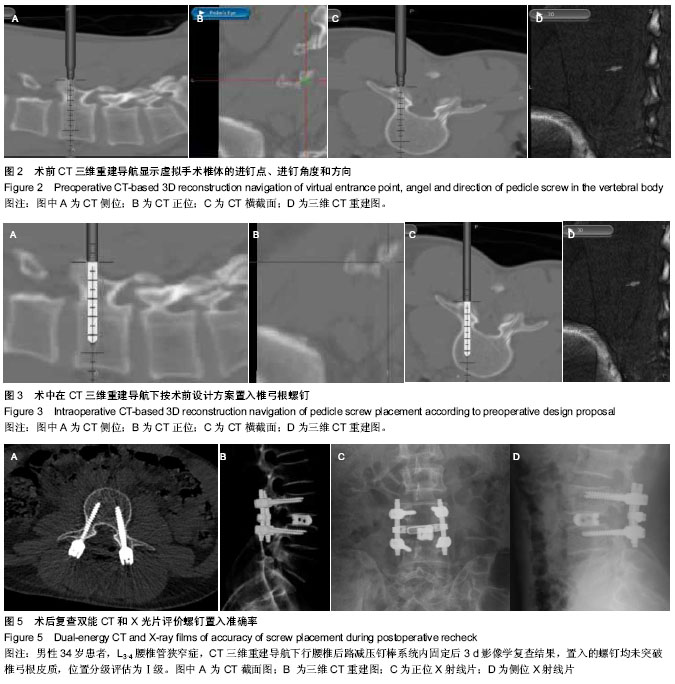
| [1] Botolin S, Merritt C, Erickson M. Aseptic loosening of pedicle screw as a result of metal wear debris in a pediatric patient. Spine (Phila Pa 1976).2013;38(1):E38-42. [2] Gelalis ID, Paschos NK, Pakos EE, et al. Accuracy of pedicle screw placement: a systematic review of prospective in vivo studies comparing free hand, fluoroscopy guidance and navigation techniques. Eur Spine J. 2012;21(2):247-255. [3] Suk SI, Kim JH, Kim SS, et al. Pedicle screw instrumentation in adolescent idiopathic scoliosis (AIS). Eur Spine J. 2012; 21(1):13-22. [4] Verlaan JJ, Dhert WJ, Oner FC. Intervertebral disc viability after burst fractures of the thoracic and lumbar spine treated with pedicle screw fixation and direct end-plate restoration. Spine J. 2013;13(3):217-221. [5] Min K, Sdzuy C, Farshad M. Posterior correction of thoracic adolescent idiopathic scoliosis with pedicle screw instrumentation: results of 48 patients with minimal 10-year follow-up. Eur Spine J. 2013;22(2):345-354. [6] Yoshihara H, Passias PG, Errico TJ. Screw-related complications in the subaxial cervical spine with the use of lateral mass versus cervical pedicle screws: a systematic review. J Neurosurg Spine. 2013;19(5):614-623. [7] Nakashima H, Yukawa Y, Imagama S, et al. Complications of cervical pedicle screw fixation for nontraumatic lesions: a multicenter study of 84 patients. J Neurosurg Spine. 2012; 16(3):238-247. [8] 杨明坤,刘川,张旭,等.上胸椎椎弓根螺钉固定并发症的探讨[J].实用骨科杂志,2014,20(6):500-503. [9] Larson AN, Polly DW Jr, Guidera KJ, et al. The accuracy of navigation and 3D image-guided placement for the placement of pedicle screws in congenital spine deformity. J Pediatr Orthop. 2012;32(6):e23-29. [10] Zwingmann J, Hauschild O, Bode G, et al. Malposition and revision rates of different imaging modalities for percutaneous iliosacral screw fixation following pelvic fractures: a systematic review and meta-analysis. Arch Orthop Trauma Surg. 2013;133(9):1257-1265. [11] Nolte LP, Zamorano LJ, Jiang Z, et al. Image-guided insertion of transpedicular screws. A laboratory set-up. Spine (Phila Pa 1976). 1995;20(4):497-500. [12] Lehman RA Jr, Kang DG, Lenke LG, et al. Return to sports after surgery to correct adolescent idiopathic scoliosis: a survey of the Spinal Deformity Study Group. Spine J. 2013. in press. [13] Luo TD, Polly DW Jr, Ledonio C, et al. Accuracy of Pedicle Screw Placement in Children≤10 Years Using Navigation and Intraoperative CT. J Spinal Disord Tech. 2014. in press. [14] Youkilis AS, Quint DJ, McGillicuddy JE, et al. Stereotactic navigation for placement of pedicle screws in the thoracic spine. Neurosurgery. 2001;48(4):771-778; discussion 778-779. [15] Foley KT, Simon DA, Rampersaud YR. Virtual fluoroscopy: computer-assisted fluoroscopic navigation. Spine (Phila Pa 1976). 2001;26(4):347-351. [16] Smith HE, Welsch MD, Sasso RC, et al. Comparison of radiation exposure in lumbar pedicle screw placement with fluoroscopy vs computer-assisted image guidance with intraoperative three-dimensional imaging. J Spinal Cord Med. 2008;31(5):532-537. [17] 叶斌,孟祥龙,刘玉增,等.徒手置钉技术在脊柱畸形矫正中的准确性与安全性研究[J].脊柱外科杂志,2014,12(1):25-34. [18] Kim YJ, Lenke LG, Bridwell KH, et al. Free hand pedicle screw placement in the thoracic spine: is it safe? Spine (Phila Pa 1976). 2004;29(3):333-342; discussion 342. [19] Hicks JM, Singla A, Shen FH, et al. Complications of pedicle screw fixation in scoliosis surgery: a systematic review. Spine (Phila Pa 1976). 2010;35(11):E465-470. [20] 张余,尹庆水,徐国洲,等.胸腰椎椎弓根钉内固定术并发症的分析[J].中国矫形外科杂志,2001,8(4):334-336. [21] Luther N, Iorgulescu JB, Geannette C, et al. Comparison of Navigated Versus Non-Navigated Pedicle Screw Placement in 260 Patients and 1434 Screws: Screw Accuracy, Screw Size, and the Complexity of Surgery. J Spinal Disord Tech. 2013. in press. [22] Uehara M, Takahashi J, Hirabayashi H, et al. Perforation rates of cervical pedicle screw insertion by disease and vertebral level. Open Orthop J. 2010;4:142-146. [23] Hyun SJ, Kim YJ, Cheh G, et al. Free Hand Pedicle Screw Placement in the Thoracic Spine without Any Radiographic Guidance : Technical Note, a Cadaveric Study. J Korean Neurosurg Soc. 2012;51(1):66-70. [24] Faizan A, Kiapour A, Kiapour AM, et al. Biomechanical analysis of various footprints of transforaminal lumbar interbody fusion devices. J Spinal Disord Tech. 2014;27(4): E118-127. [25] Zang L, DU P, Hai Y, et al. Device related complications of the Coflex interspinous process implant for the lumbar spine. Chin Med J (Engl). 2013;126(13):2517-2522. [26] Paik H, Kang DG, Lehman RA Jr, et al. The biomechanical consequences of rod reduction on pedicle screws: should it be avoided? Spine J. 2013;13(11):1617-1626. [27] Joglekar SB, Mehbod AA. Surgeon's view of pedicle screw implantation for the monitoring neurophysiologist. J Clin Neurophysiol. 2012;29(6):482-488. [28] 池永龙,徐华梓,林焱,等.微创经皮椎弓根螺钉内固定治疗胸腰椎骨折的初步探讨[J].中华外科杂志,2004,42(21):1307-1311. [29] Zhang QS, Lü GH, Wang XB, et al. The significance of removing ruptured intervertebral discs for interbody fusion in treating thoracic or lumbar type B and C spinal injuries through a one-stage posterior approach. PLoS One. 2014; 9(5):e97275. [30] 吴静,茅金宝,孔祥云,等.导航与普通透视对手术室医务人员放射量的对比分析[J].医学影像学杂志,2013,23(10):1631-1634. [31] Van de Kelft E, Costa F, Van der Planken D, et al. A prospective multicenter registry on the accuracy of pedicle screw placement in the thoracic, lumbar, and sacral levels with the use of the O-arm imaging system and StealthStation Navigation. Spine (Phila Pa 1976). 2012;37(25):E1580-1587. [32] Lee MH, Lin MH, Weng HH, et al. Feasibility of Intra-operative Computed Tomography Navigation System for Pedicle Screw Insertion of the Thoraco-lumbar Spine. J Spinal Disord Tech. 2012. in press. [33] 田伟,刘亚军,刘波,等.计算机导航在脊柱外科手术应用实验和临床研究[J].中华骨科杂志,2006,26(10):671-675. |
| [1] | Xu Feng, Kang Hui, Wei Tanjun, Xi Jintao. Biomechanical analysis of different fixation methods of pedicle screws for thoracolumbar fracture [J]. Chinese Journal of Tissue Engineering Research, 2021, 25(9): 1313-1317. |
| [2] | Lu Dezhi, Mei Zhao, Li Xianglei, Wang Caiping, Sun Xin, Wang Xiaowen, Wang Jinwu. Digital design and effect evaluation of three-dimensional printing scoliosis orthosis [J]. Chinese Journal of Tissue Engineering Research, 2021, 25(9): 1329-1334. |
| [3] | Zhang Tongtong, Wang Zhonghua, Wen Jie, Song Yuxin, Liu Lin. Application of three-dimensional printing model in surgical resection and reconstruction of cervical tumor [J]. Chinese Journal of Tissue Engineering Research, 2021, 25(9): 1335-1339. |
| [4] | Yao Rubin, Wang Shiyong, Yang Kaishun. Minimally invasive transforaminal lumbar interbody fusion for treatment of single-segment lumbar spinal stenosis improves lumbar-pelvic balance [J]. Chinese Journal of Tissue Engineering Research, 2021, 25(9): 1387-1392. |
| [5] | Wang Haiying, Lü Bing, Li Hui, Wang Shunyi. Posterior lumbar interbody fusion for degenerative lumbar spondylolisthesis: prediction of functional prognosis of patients based on spinopelvic parameters [J]. Chinese Journal of Tissue Engineering Research, 2021, 25(9): 1393-1397. |
| [6] | Chen Jinping, Li Kui, Chen Qian, Guo Haoran, Zhang Yingbo, Wei Peng. Meta-analysis of the efficacy and safety of tranexamic acid in open spinal surgery [J]. Chinese Journal of Tissue Engineering Research, 2021, 25(9): 1458-1464. |
| [7] | Zhang Wei, Hu Jiang, Tang Liuyi, Wan Lun, Yu Yang, Lin Shu, Tang Zhi, Wang Fei. Advantages of robot assisted percutaneous biopsy in the diagnosis of spinal lesions [J]. Chinese Journal of Tissue Engineering Research, 2021, 25(6): 844-848. |
| [8] | He Li, Tian Wei, Xu Song, Zhao Xiaoyu, Miao Jun, Jia Jian. Factors influencing the efficacy of lumbopelvic internal fixation in the treatment of traumatic spinopelvic dissociation [J]. Chinese Journal of Tissue Engineering Research, 2021, 25(6): 884-889. |
| [9] | Xie Zhifeng, Liu Qing, Liu Bing, Zhang Tao, Li Kun, Zhang Chunqiu, Sun Yanfang. Biomechanical characteristics of the lumbar disc after fatigue injury [J]. Chinese Journal of Tissue Engineering Research, 2021, 25(3): 339-343. |
| [10] | Liang Yan, Zhao Yongfei, Zhu Zhenqi, Liu Haiying, Mao Keya. Minimally invasive transforaminal lumbar interbody fusion in the treatment of sciatic scoliosis caused by lumbar disc herniation: a 2-year follow-up of coronal and sagittal balance [J]. Chinese Journal of Tissue Engineering Research, 2021, 25(3): 409-413. |
| [11] | Yu Langbo, Qing Mingsong, Zhao Chuntao, Peng Jiachen. Hot issues in clinical application of dynamic contrast-enhanced magnetic resonance imaging in orthopedics [J]. Chinese Journal of Tissue Engineering Research, 2021, 25(3): 449-455. |
| [12] | Hu Jing, Xiang Yang, Ye Chuan, Han Ziji. Three-dimensional printing assisted screw placement and freehand pedicle screw fixation in the treatment of thoracolumbar fractures: 1-year follow-up [J]. Chinese Journal of Tissue Engineering Research, 2021, 25(24): 3804-3809. |
| [13] | Sun Maji, Wang Qiuan, Zhang Xingchen, Guo Chong, Yuan Feng, Guo Kaijin. Development and biomechanical analysis of a new anterior cervical pedicle screw fixation system [J]. Chinese Journal of Tissue Engineering Research, 2021, 25(24): 3821-3825. |
| [14] | Wang Ziao, Song Wenhui, Liu Changwen . Short-segment fixation of thoracolumbar burst fractures: method modification and strategies to reduce failure [J]. Chinese Journal of Tissue Engineering Research, 2021, 25(24): 3902-3907. |
| [15] | Wei Yuanbiao, Guo Huizhi, Zhang Shuncong. Finite element analysis of cortical bone trajectory screw fixation on adjacent segments [J]. Chinese Journal of Tissue Engineering Research, 2021, 25(18): 2799-2804. |
| Viewed | ||||||
|
Full text |
|
|||||
|
Abstract |
|
|||||
